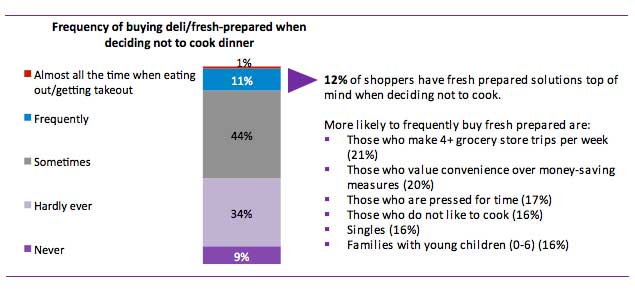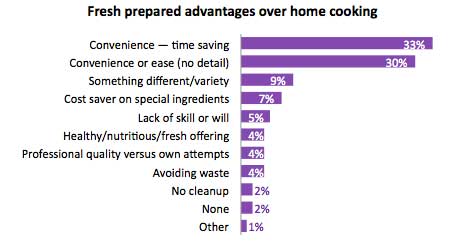Last updated on March 6th, 2017 at 04:37 pm
by Anne-Marie Roerink/Principal, 210 Analytics; and Rick Stein/VP of fresh food, FMI
Opportunities for deli growth are bright. These departments allow shoppers to have a hand in preparing tonight’s dinner—or not. The deli can offer a complete meal solution as an alternative to cooking, or a ready-to-eat (side) dish in combination with items cooked from scratch.
While market factors are positive, there is one significant hurdle for retailers: simply being on the shopper radar at the critical hour. To aggressively grow deli/fresh prepared, retailers must find ways to get more people in the store and into the deli department. Nielsen finds that only about one in 10 store visits today includes a stop in the deli/fresh prepared department. Additionally, trips are falling, both to the total store and the deli, on a year-over-year basis. Complicating things further, prime prospects—those who eat out more often—are in the store even less frequently.
What does this mean for food retailers? Even though 96 percent of shoppers purchase deli/fresh prepared once a year, few consumers think of visiting the deli with regularity when deciding what to do instead of cooking dinner (12 percent). More simply put, most of the time when thinking through dinner options, the supermarket deli is simply not even part of shoppers’ consideration set.

Taking a page from the restaurant industry
With their singular focus, restaurants have an important advantage in the dinner choice. Food retailers need to focus on elevating the profile of deli/fresh prepared, not just as a department for shoppers who are already in the store, but as a stand-alone destination and a viable restaurant alternative.
I (Anne-Marie) was reminded of this with a new restaurant opening a mere few doors from my primary grocery store. Entering their shared parking lot weeks before the grand opening, a big banner greeted visitors with a “coming soon” announcement. Similar banners adorned the building itself; flyers and menus were handed out to anyone parking in the vicinity; ads appeared in neighborhood magazines; menus were delivered door-to-door; and upon opening, a person flagged down people on the main road by twirling a sign. As evidenced by the chitchat at a birthday party with fellow locals, the restaurant was part of the conversation long before it had even opened. It made me wonder, would these people know if the grocery store next door added space, cuisines or meal kits in the deli department?
According to The Power of Fresh Prepared/Deli, the answer is a disturbing “probably not.” All the top-rated ways in which shoppers find out about a store’s deli/fresh prepared program require them to be in the store: 52 percent learn from their own experience or observation. This was almost twice as high as the second reason listed, in-store signage, at 27 percent. The store’s outreach, which could reach non-shoppers, was lowest on the list and led by the circular, at 18 percent. Social media, apps and food rating websites, such as Yelp, were rated as a source of information by less than 5 percent of shoppers.
As such, retailers who want to truly differentiate in deli/fresh prepared should go back to the basics: get on the shopper radar as a top-of-mind alternative to a) cooking dinner, and b) restaurant meals. After all, when the deli/fresh prepared offering goes unnoticed among primary shoppers or fails to be a draw to secondary shoppers by lack of awareness or excitement, retail loses out from the start.
But reputation is where we struggle
With some noted exceptions, reputation is precisely where many grocery stores struggle. Across channels and banners, shoppers today do not see deli/fresh prepared as an important driver in primary store choice. For years, FMI’s U.S. Grocery Shopper Trends has been tracking the importance of 32 features relative to primary store choice—with price image, high-quality meat and produce, product variety, cleanliness and location being top-scoring items every year. Deli/fresh prepared ranked 15th in the 2015 study and has held a similar position for more than a decade.
To build a reputation, retailers must find ways to drive awareness and a buzz—much like the new restaurant opening next door. Optimal in-store execution is evident, but building a reputation among non-shoppers involves a time and effort commitment involving many communication vehicles. Additionally, messaging and message platforms should be segmented by audience.
Overall, email is the preferred vehicle to receive messages about “tonight’s fresh prepared dinner,” with texts being the least popular except among price-driven consumers. Digital, mobile and social media can be a strong alley to reach younger shoppers. The circular remains an important way to reach older generations. Importantly, when relevance of fresh prepared rises as a solution for the household, so does interest in receiving messaging on offers. As such, targeted, personalized and segmented offerings become even more important to prove value for the recipient. Given demographics, shoppers enrolled in baby- or new mother-type programs may also show growing interest in fresh prepared in years to come.
But if shoppers are aware, our image is strong
What retailers lack on the awareness front, they make up in image. Deli/fresh-prepared scores many pluses when compared with home cooking and restaurant meals.
In a direct comparison to home-cooked meals, convenience is the overarching theme in deli/fresh prepared, including time-saving in planning, preparation and cleanup.
Additionally, the extensive variety helps suit different preferences among household members.
Beyond convenience, other important advantages are saving money on food that gets discarded due to making too much or avoiding the need to buy special ingredients; a solution for those who cannot or do not want to cook; and leaving the cooking to professionals. The latter is very important. Just like retailers are emphasizing butchers in the meat department, the chef image can be important in driving the quality image of fresh prepared.

The ability to combine grocery shopping with picking up fresh prepared items for tonight’s dinner is the biggest advantage grocery stores have over restaurants, according to 53 percent of respondents. Speed or saving time over purchasing from a restaurant is in close second. Closing out the top three is the cost or value for the money, cited by a little more than four in 10 shoppers.
*Editor’s note: The Power of Fresh Prepared/Deli is a product of the Food Marketing Institute, commissioned by the FMI Fresh Foods Leadership Council, made possible by Nielsen, Hussman and The Shelby Report, and conducted by 210 Analytics. This is Part 2 of a four-part series examining the report’s findings. Part 2 also appears in the March 2017 print editions of The Shelby Report. Find Part 1 here.






